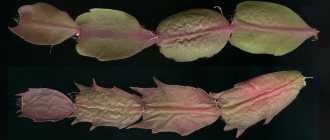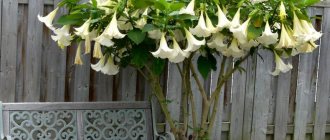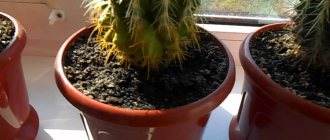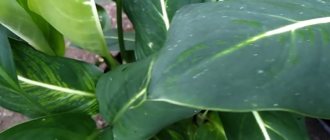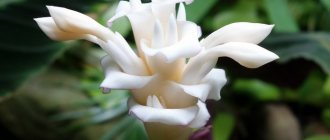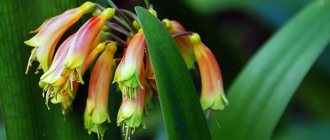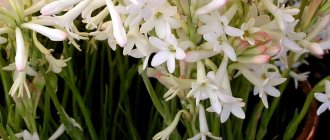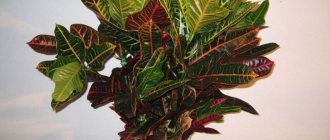The homeland of arrowroot is South America. This is a perennial herbaceous plant. Lovers of indoor flowers appreciate it for the unusual color of the leaf plate. It can be any shade of green.
The leaf has an oval shape, decorated with veins and spots of contrasting color. Arrowroot is a flowering plant; its flower forms a small spikelet.
Arrowroot tricolor
It is distinguished by red veins on the leaf blade. The color of the leaves also contains green and yellow. The reverse side of the sheet is painted crimson.
Varietal diversity
When growing at home, they often use:
- The most popular three-colored species has a contrast of central and lateral reddish veins on a leaflet resembling a fish ridge in appearance, and a crimson underside.
- A two-color type with a striped top and a pubescent bottom with wavy leaves at the edges.
- Reed giantess over 100 cm in size with pointed foliage with fluff.
- Kerkhovena or “Rabbit's Foot” is a low-growing perennial with leaf spots that look like eyes and feathers; at the bottom the red color turns into blue.
- Miniature Massanja with brownish-olive spots.
- A white-veined subspecies with white veins.
Morantha flowers - white, cream, lilac inflorescences in the form of a spike cannot be called spectacular; they are usually removed, preserving the maternal powers and not using the seeds to obtain new samples.
Light
The arrowroot plant loves light, but direct sunlight can be harmful to it. If there is too much light, the color of arrowroot leaves may lose its brightness and richness.
If there is not enough light, the leaves will be small and inconspicuous. Experienced gardeners recommend placing the pot with the plant on the western or eastern side, where there is diffused sunlight.
If there is enough lighting, then its leaves will be located horizontally, and in low light they will begin to stretch vertically.
Diseases
Care at home requires close attention to the whimsical culture. Yellowing of the tips of the leaves, their falling and slowing of growth indicates a lack of moisture and dryness of the surrounding atmosphere.
The sissy gets sick in a cold room and with diligent watering, which provokes the appearance of rot on the roots and stems. The bush becomes faded from direct exposure to the sun.
A spider mite attack is possible; in this case, treatment is carried out with garlic, onion tincture or Actellik.
Moisture
Arrowroot loves moisture, but it is better not to water it abundantly, but to spray it frequently, at least twice a day. The soil should be slightly moist; in winter, even dry soil is allowed.
It is recommended to use purified warm water when watering to avoid limescale deposits on the leaves. You can also place the plant next to the aquarium to maintain the required humidity.
general information
Arrowroot is an ornamental herbaceous perennial from the family of the same name. Different species differ significantly in appearance and size. Indoor arrowroot most often grows up to 30 cm, but in the wild its growth reaches 1.5 m.
The large patterned leaves of arrowroot are especially prized. Most often they are oval, with protruding veins, colored spots or strokes. In the evening, she raises the leaves up, and during the day they are oriented towards the sun. For this feature, arrowroot is called prayer.
Arrowroot is a tuberous plant, and the tubers of some species are edible. Sometimes it blooms in summer, but its flowering has no decorative value at all. The buds are small, pale and completely inconspicuous, so they are often cut off so that the flower does not waste energy.
Photo: zen.yandex.ru
Top dressing
To strengthen and grow well, it is necessary to water the arrowroot, adding mineral and organic substances to the water. In summer this is done twice a month, in winter once is enough.
Considering that arrowroot comes from the tropics, it is recommended to create an appropriate climate at home for comfortable growing conditions for this beautiful plant. If these requirements are met, the plant will always have bright and lush foliage.
Useful qualities
Arrowroot flour is made from the tubers of the plant. This dietary product treats anemia and anorexia. It contains no proteins and fats, but is high in fiber and ash. The composition also includes folic acid, vitamins PP and B9, calcium. The product has a general strengthening effect, promoting:
- removing toxins from the body;
- lowering blood sugar;
- normalization of sleep;
- improving brain activity.
This natural thickener is an analogue of corn and potato starch and should definitely be included in the family diet. Contraindications for use include individual intolerance, stomach ulcers, and surgical interventions.
Maranta's photos demonstrate her stunning decorativeness, enlivening any interior with its beauty. In addition, there is an opinion that it suppresses negative energy, preventing quarrels and conflict situations in the family.
A non-trivial flower, the sign of Aquarius is the choice of creative, active people. It is a symbol of prosperity, and its flourishing promises monetary profit. In England, a pot with an outlandish bush is a mandatory attribute of virtually every home, called the “10 Commandments.”
Transfer
Arrowroot is usually planted in plastic pots, since ceramic ones contribute to hypothermia of the tubers in winter. The pot itself should be wide enough. It is necessary to place drainage at the bottom, then use loose soil mixed with sand or peat.
It is recommended to do the first transplant after three years. Subsequently, the young plant is replanted in the spring every year, and then, if necessary, the flower pot is replaced with a more spacious one. But at least once every four years.
- Advantages of Gardena gardening equipment
Bathhouse made of 6x6 timber
- Ktenanta - types, cultivation characteristics and instructions for care at home. 110 photos of plants
Watering
For irrigation you will need clean soft water up to 5 °C above room temperature. In summer, the flower needs increased moisture, and it should be watered at least once every 48 hours. In this case, it is necessary to control the general level of humidity of the substrate so that the roots do not rot.
For additional moisture, initially place the arrowroot on a tray filled with gravel or expanded clay filled with water.
In winter, water the flower no more than 1-2 times a week, depending on the degree of dry air caused by the heating season.
How to organize watering during a long absence?
The lack of necessary moisture leads to rapid drying out of the arrowroot. If you are going on vacation, make sure in advance that the flower has access to a source of moisture. To do this, you can use 3 options:
- Place wet sphagnum moss on the surface of the substrate. This will help retain moisture in the roots.
- Place a layer of expanded clay, pebbles or sand in a drainage pan and fill everything with water. Place the arrowroot on top so that the bottom of the pot does not directly touch the water.
- If possible, place the plant in a florarium.
Reproduction
There are two types of arrowroot propagation:
- Separation when transplanting tubers.
In this case, a tuber with roots and several leaves is selected. Place in a prepared pot with moistened soil and cover with film for several days to maintain the required humidity.
- Cuttings.
At the beginning of summer, a small cutting with two to three leaves is cut from the tops of the shoots and placed in a container with water. Once the roots appear, it will be possible to plant them in a separate pot. In addition, pruning elongated shoots allows you to form the desired shape of the plant and also promotes the appearance of new leaves.
Pests
There are two dangerous pests for arrowroot - scale insects and spider mites.
Shchitovka
A very small insect, up to 5 mm in size, with a waxy shield that completely covers its body. Appears on the flower if care is not accompanied by regular air humidification; it feeds on arrowroot juice.
Affected leaves can be easily identified by raised bumps or plaques of green, brown or yellow color on the outside or inside. If the arrowroot is infected quite recently, and the scale insect is not yet visible to the naked eye, it can be detected by the sticky secretion on the flower that it leaves.
Insect control is carried out using a soap solution and insecticides. Using a cotton swab dipped in soapy water, thoroughly wipe the leaves to remove adult insects.
The same can be done using Karbofos solution. After this, spray the flower with one of the following products: Aktara, Bankol, Mospilan, Actellik or their analogues. At the same time, do not forget to treat the surface on which the flower stands.
If the arrowroot is on the windowsill, even the nearest window glass must be treated.
Spider mite
Microscopic arthropod insect. Infected leaves are distinguished by small yellow dots, which subsequently merge into one large spot. The mite appears due to dry air; in some cases, the cause is called, on the contrary, excessive humidity. At the same time, the tick can be brought into the apartment already on the leaves of an infected arrowroot, in a purchased substrate, or in the soil from the street.
Get rid of the pest by wiping the leaves and stem with soapy water and acaricides. Among the most effective are Vertimek, Akarin, Neoron, Fitoverm and Actellik.
To prevent scale insects and spider mites, do not forget to systematically moisten the room where the flower is located. Do not place any purchased cut bouquets next to arrowroot. And keep all new purchased plants in a 3-week quarantine in another room.
Lighting rules
Arrowroot is a very shade-tolerant plant, so it should not be kept on southern windowsills. But if there is no other possibility, then it will be additionally necessary to create good shading. In bright light, the crop loses its decorative coloring, and the foliage decreases in size. The same will happen due to low light in the room, the lack of which can be easily determined by the leaves raised up. It should be noted that this flower responds positively to artificial lighting, for which fluorescent lamps are used. They must be used for 16 hours every day.
Apical cuttings
Rooted cuttings of the plant can be used for propagation. If the flower produces many long shoots, then they are cut so that they are at least 10 cm long, as well as several leaves with a node in the lower area. After this, they are planted in moist soil, which consists of equal amounts of sand and peat. The cuttings are covered with plastic wrap or glass jars, and then sent to a warm room. To do this, you can use mini-greenhouses where there will be high air humidity.
In addition, the cuttings can be placed in water, where a growth stimulator and activated carbon are added. As a rule, within a month and a half the cuttings will form roots. When their length is about 2.5 cm, the young plants are transplanted into the substrate; they should be provided with shelter and placed in a warm place.
Signs and superstitions
Maranta, according to superstition, enriches the one who owns the place where it is located. Thanks to this property, the most successful solution would be to install the flower where most of the family works or rests (for example, the kitchen or living room).
In addition, arrowroot is the keeper of the hearth, brings peace, tranquility and comfort to the house, normalizes the atmosphere, helps rid the family of irritability and insomnia, and attracts wealth to the house. If it begins to bloom, then this is a sure sign that your material well-being will soon improve.
Placed at the head of a sick person, it can stabilize his condition. Its most useful property is considered to be the ability to reduce negativity. Maranta is able to help a wife stop scandals with her husband, and a mother to calm a violent and disobedient child.
Arrowroot is not suitable for bonsai formation. However, it is already an excellent decoration for the home.

